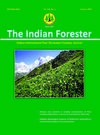Altitude Wise Variation in Seedling Characteristics of Picea smithiana (Wall.) Boiss. In Forests of South Kashmir, J & K, India
DOI:
https://doi.org/10.36808/if/2018/v144i1/121295Keywords:
Altitudinal Variation, Cone, Seedling, Picea smithiana, Germination.Abstract
The study was carried out in Jammu and Kashmir under four forest divisions (Lidder, Anantnag, Kulgam and Shopian) 0 which falls under three altitudinal zones (<2200m-Lower, 2200-2600m-Middle and >2600m-Upper) (latitude 30°37' to 34 55' N and longitude 74°44' to 75°25' E) relating to seed and seedling characteristics of Picea smithiana which indicated significant variation among seed and seedling parameters. Number of seeds per cone averages at 123 at lower, 173.26 at middle and 98.38 at upper altitudes. Germination study reveals that germination percent at maturity was 28.96 at lower, 42.6 at middle and 19.24 at higher altitude. Germination energy was 18.64 at lower, 23.18 at middle and 10.55 at higher altitude, germination energy index was 35.05 at lower, 41.34 at middle and 31.72 at higher altitude. Seeds of mid altitudes under laboratory conditions showed better performance in terms of hypocotyl length, radical length, number of cotyledons, total seedling length and vigour index. In seedlings raised from seed sources at lower altitude (A1) shows that bud break takes place in the first fortnight of April, in mid altitude (A2) it takes place in second fortnight of April and in higher altitude (A3 altitude) the bud break takes place in first fortnight of May.References
Bagchi S.K. and Dobriyal N.D. (1990). Provenance variation in seed parameters of Acacia nilotica. Indian Forster, 116 (12): 958-961.
Bliss L.C. (1971). Arctic and alpine plant life cycles. Annual Review of Ecology, Evolution and Systematics, 2: 405–438.
Chauhan P.S. and Raina V. (1980). Effect of seed weight on germination and growth of chir pine (Pinus roxburghii Sargent). Indian Forester, 16(1):53-59.
Dormling I. (1979). Influence of light and temperature on photoperiodic response of Norway spruce provenances. Proceeding IUFRO Norway spruce Meeting Bucharest, 398-408 pp.
Ginwal H.S., Rawat P.S., Gera M., Gera N. and Srivastava R.L. (1995). Study on the pattern of seed germination of various sub species cum provenances of Acacia nilotica under nursery condition. Indian Forester, 121 (1): 29-38.
Hulber K., Winkler M. and Grabherr G. (2010). Intra-seasonal climate and habitat specific variability controls the flowering phenology of high alpine plant species. Functional Ecology, 24: 245-252.
Inouye D.W. (2008). Effects of climate change on phenology, frost damage, and floral abundance of montane wildflowers. Ecology, 89: 353-362.
ISTA (1993). International Seed Testing Association. International rules for seed testing. Seed Science and Technology, 21: 1- 288.
Kandya A.K. (1978). Relationship among seed weight and various growth factors in Pinus oocarpa Schide seedlings. Indian Forest Research, 104 (8): 561-567.
Kozlowski T.T. and Borger G.A. (1971). Effect of temperature and light intensity early in ontogeny on growth of Pinus resinosa seedlings. Canadian J. Forest Research, 1:57-65.
Kumar A. (1979). Effect of fruit size and source on germination of teak (Tectona grandis Linn) seeds. Sri Lanka Forester, 14 (1&2): 58-63.
Kumar N. and Toky O. P. (1993). Variation in pod and seed size among Albizia lebbek provenances. Nitrogen Fixing. Tree Research Report, 2: 64-67.
Langdon P.G. (1958). Cone and seed size on South Florida slashpine and their effects on seedling size and survival. Journal of Forestry, 56: 122-127.
Lovell P.H. and Moore K.G. (1970). A Comparative Study of cotyledons as assimilatory organs. J. Experimental Botany, 21:1017-1030.
Marshall P.E. and Kozlowski T.T. (1976). Compositional changes in cotyledons of woody angiosperms. Canadian J. Botany, 54:2473-2477.
Mughal A.H., Bhat G.M. and Khan M.A. (2007). Maturity indices for harvesting of Cryptomeria japonica (Don.) cones under temperate conditions of Kashmir valley. Environment and Ecology, 255(3A): 872-874.
Mughal A.H. and Thapliyal R.C. (2006). Cone and seed maturity indices in Cedrus deodara (D. Don, G. Don). Indian J. Forestry, 29 (2): 167-174.
Rehfeldt G.E. and Wycoff W.R. (1981). Periodicity in shoot elongation among populations of Pinus contorta from the Northern rocky mountain. Annals of Botany, 48:371-377.
Roy S.M., Thapliyal R.C. and Phartyal S.S. (2004). Seed source variation in cone, seed and seedling characteristics across the Natural distribution of Himalayan low level Pine Pinus roxburghii Sarg. Silvae Genetica, 53 (3): 116-128.
Sasaki S. Kozlowski T.T. (1968). The role of cotyledons in early development of pine seedlings. Canadian Journal Botany, 46:1173-1183.
Sasaki S. and Kozlowski T.T. (1969). Utilization of seed reserves and currently produced photosynthesis by embryonic tissues of pine seedlings. Annuals of Botany, 33:473-82.
Sasaki S. and Kozlowski T.T. (1970). Effect of cotyledons and hypocotyls photosynthesis on growth of young pine seedlings. New Phytology, 69:493-500.
Sharma N.K., Burman U., Tewari J.C., Bohra M.D. and Herah L.N. (1994). Variability studies in pod and seed characteristics of Prosopis juliflora. Indian J. Forestry, 17 (2): 161-165.
Singh A. (2011). Standardization of nursery technology for Allepo pine-Pinus halpensis: An introduced pine in valley. Ph.D. Thesis submitted to S.K. University of Agricultural Sciences and technology of Kashmir, Shalimar Srinagar.
Sorensen F.C. (1979). Provenance variation in Pseudotsuga menziesii seedlings from the var. menziesii and glauca transction zone in Oregon. Silvae Genetica, 28:96-103.
Troups R.S. (1986). The Silviculture of Indian Trees. 3: 1143-1153.
Wipf S. (2010). Phenology, growth and fecundity of eight subarctic tundra species in response to snowmelt manipulations. Plant Ecology, 207:53–66.
Wood D.W., Longden P.C. and Scott R.K. (1977). Seed size variation, its extent source and significance in field crops. Seed Science and Technology, 2: 337-352.
Downloads
Downloads
Published
How to Cite
Issue
Section
License
Unless otherwise stated, copyright or similar rights in all materials presented on the site, including graphical images, are owned by Indian Forester.





